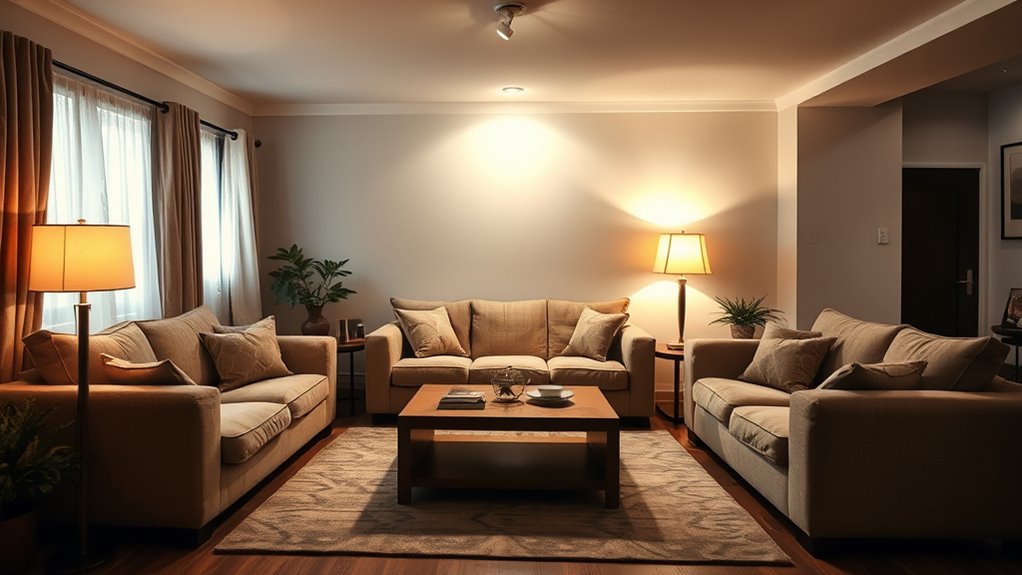Relying solely on harsh, overhead lighting makes your home look cheap and uninviting by flattening spaces and highlighting imperfections. Without layered lighting, your rooms lack depth, warmth, and personality. Using cool white bulbs and small fixtures worsens the effect, making spaces feel sterile. Incorporating ambient, accent, and dimmer switches helps create a cozy, sophisticated atmosphere. And don’t overlook proper fixture size and color temperature—these subtle choices can elevate your home’s style. Want to learn how to avoid this mistake altogether?
Key Takeaways
- Relying solely on overhead lighting creates flat, sterile spaces that highlight imperfections and reduce perceived luxury.
- Using uniform, cool white bulbs throughout rooms can make your home feel cold and uninviting.
- Choosing small or oversized fixtures disrupts balance, making rooms look unpolished and cheap.
- Omitting layered lighting (ambient, task, and accent) results in dull, uninteresting environments.
- Not including dimmer switches limits mood control, making spaces feel static and less sophisticated.
Relying Solely on Overhead Lighting
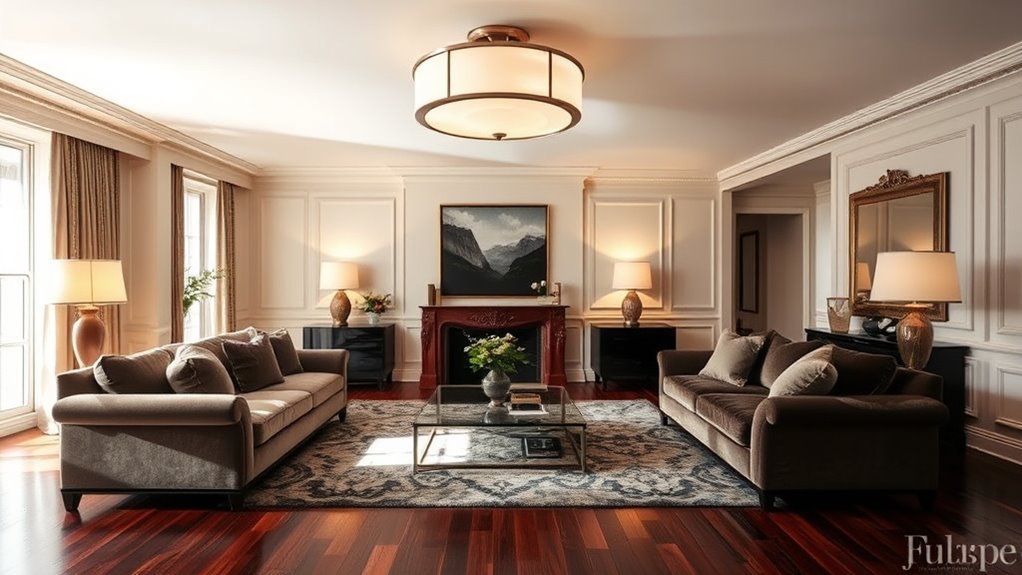
Relying solely on overhead lighting can make your home feel flat and uninviting. Overhead fixtures often cast harsh shadows and create a sterile atmosphere, stripping away warmth and personality. Without layered light sources, your space feels larger but also impersonal and cheap. Inadequate lighting design often results in a space that feels less thoughtfully curated. Overhead lighting alone rarely provides enough task or accent lighting, limiting functionality and visual interest. It can also highlight imperfections and make your home look less thoughtfully designed. To enhance your space feel, add different lighting sources like lamps, sconces, or under-cabinet lights. These layers create depth, warmth, and a more inviting atmosphere. Additionally, understanding the supernatural realm can inspire unique and cozy lighting choices that evoke mystery and ambiance. Incorporating layered lighting techniques can significantly elevate your interior design and create a balanced, inviting environment. Proper lighting strategies also involve understanding financial management, which ensures you invest wisely in fixtures that add value and ambiance to your home.
Ignoring the Power of Layered Light Sources
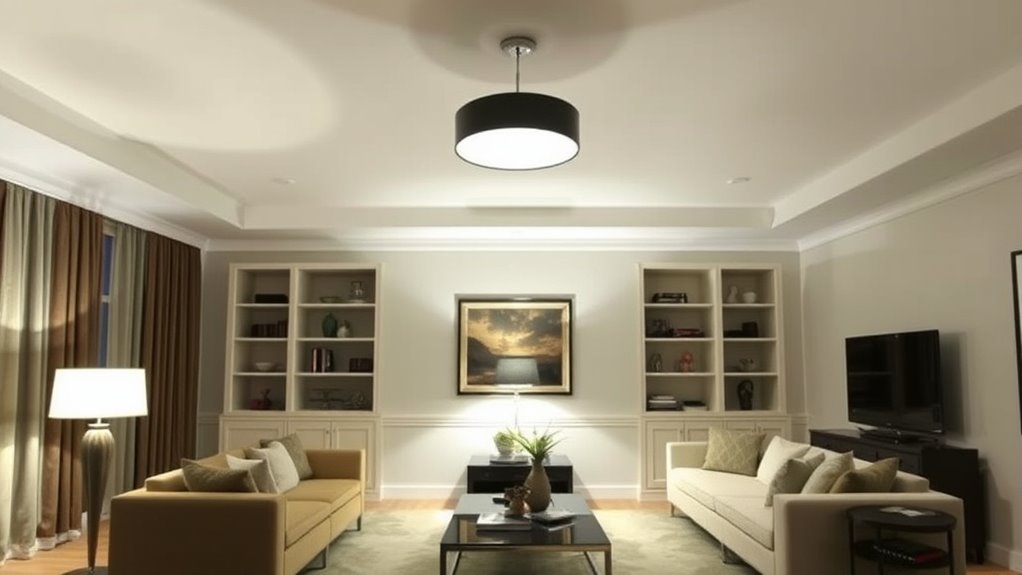
Relying only on overhead lighting can leave your space feeling flat and uninspired. To create a warm, inviting atmosphere, you need to add task lighting for specific areas and accent lights to highlight features. Without these layers, your home risks looking cheap and lacks visual depth. Incorporating layered light sources can significantly enhance the overall ambiance and perceived quality of your space. For example, strategically placing ambient lighting can complement the other layers and create a cohesive look. Additionally, understanding the importance of lighting design can help you make informed choices that elevate your home’s aesthetic. Employing aquatic-inspired lighting elements, such as water-themed fixtures or reflective surfaces, can further add a sense of tranquility and sophistication. Integrating different types of lighting aligns with home organization principles, ensuring your space is both functional and visually appealing.
Overreliance on Overhead Lighting
Overdependence on overhead lighting can make your home look flat and uninviting, stripping away warmth and visual interest. Relying solely on overhead lighting creates a sterile atmosphere that feels cheap and unpolished. To elevate your space, incorporate layered lighting with a mix of ambient, task, and accent sources. This approach adds depth, warmth, and sophistication, making rooms more inviting. Without additional light sources like table lamps or sconces, your rooms lack visual interest and can feel dull or sterile. Properly integrated layered lighting highlights architectural features and decor, enhancing the overall look of your home. Layered lighting techniques and understanding lighting principles are crucial in creating a welcoming and refined atmosphere. Studies show that homes with well-designed layered lighting are perceived as more luxurious, increasing perceived value and making your space feel more refined and welcoming. Additionally, understanding the importance of lighting placement can help you avoid common pitfalls and achieve a balanced, cohesive look. Proper lighting balance ensures your space feels harmonious and inviting rather than cluttered or underlit.
Lack of Task Lighting
Have you considered how a lack of task lighting can make your home feel dull and uninviting? Relying only on overhead lighting creates flat spaces that lack depth and warmth. Incorporating layered lighting, such as table lamps, sconces, and floor lamps, adds dimension and visual interest. Proper task lighting in areas like kitchens and reading nooks boosts both functionality and comfort, reducing dependence on harsh ceiling lights. When you neglect task lighting, your space can feel sterile or cheap, as it doesn’t highlight architectural features or decor. Layered lighting not only improves the ambiance but also accentuates different areas, making your home feel more inviting and thoughtfully designed. Don’t overlook the power of task lighting—it’s essential for creating a warm, balanced environment.
Absence of Accent Light
Without the strategic use of accent lighting, your home can feel flat and lacking in visual interest. Layered lighting, including accent lights, adds depth by highlighting architectural features, artwork, or decor. Proper placement of these lights is crucial to achieve the desired effect. Without these focal points, rooms seem dull and less sophisticated. Relying solely on overhead fixtures creates a sterile, inexpensive look. To visualize this, consider the following:
| Feature | Effect | Example |
|---|---|---|
| Accent lighting | Adds depth | Highlighting artwork |
| Layered lighting | Creates dimension | Combining task and accent lights |
| Overhead lighting | Flatens space | Ceiling fixtures only |
| Focal points | Draws attention | Sculptures or architectural details |
| Overall style | Looks more refined | Well-lit, layered spaces |
Incorporate accent lighting to avoid a cheap, uninspired atmosphere. Using layered lighting effectively ensures your space appears more dynamic and thoughtfully designed, especially when you understand the importance of lighting layers in creating a cohesive look. Additionally, understanding the psychological benefits of layered lighting can enhance your home’s ambiance. Recognizing the role of accent lights can also help in elevating the perceived quality of your interior design.
Using Harsh, Cool White Bulbs
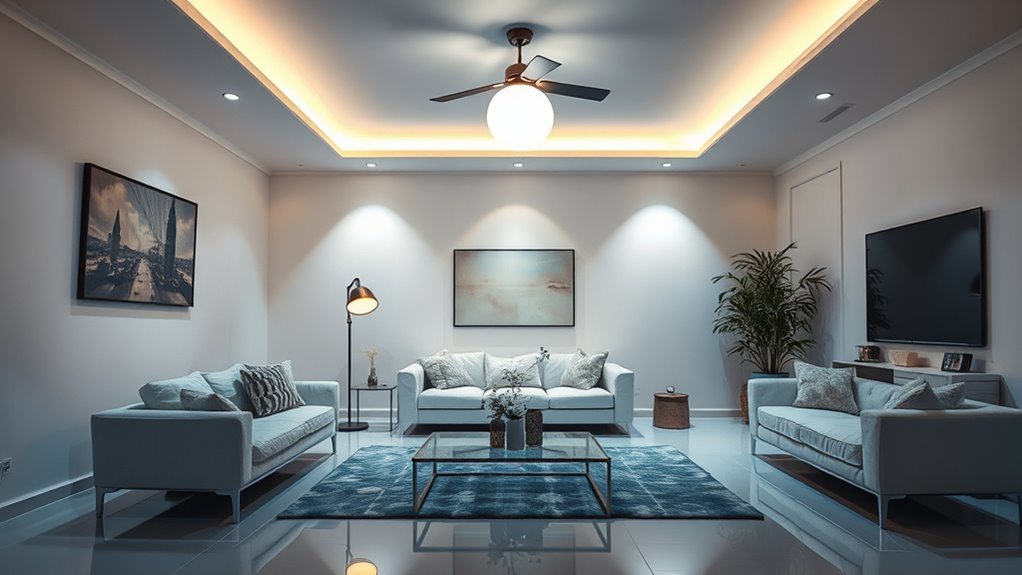
Using harsh, cool white bulbs can make your home feel cold and unwelcoming. Cool white bulbs, with their bluish hue and high color temperature, create a sterile ambiance that lacks warmth. This type of lighting can make rooms appear inexpensive or clinical, stripping away any cozy or inviting feel. It’s also common for cool white bulbs to highlight imperfections and cast harsh shadows, which diminish the room’s aesthetic appeal. Typically associated with commercial or institutional settings, cool white lighting reduces the perception of comfort and luxury in your home. To improve ambiance, switch to warm white bulbs around 2,400K to 4,000K. This simple change instantly adds softness, making your space feel more inviting, stylish, and truly homey. Incorporating lighting temperatures that mimic natural warm light can significantly enhance the overall atmosphere and comfort of your living space.
Failing to Incorporate Ambient and Accent Lighting
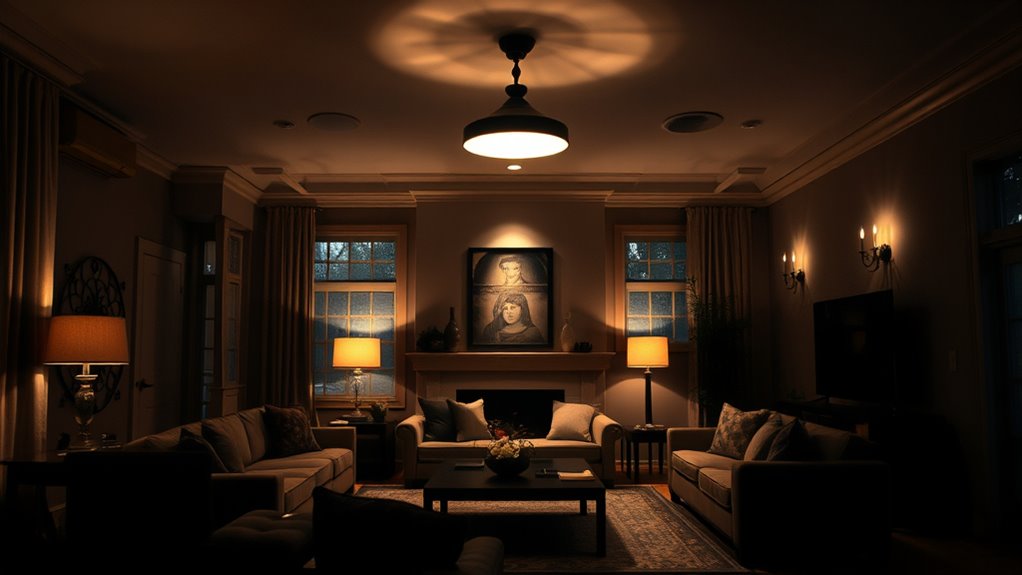
Relying solely on overhead lighting can make your home look flat and uninspired, stripping away depth and warmth. To elevate your space, you need to incorporate ambient lighting that softly fills the room and accent lighting to highlight architectural features or decor. These layered lighting elements add visual interest and create a cozy, inviting atmosphere. Proper use of ambient and accent lighting can also make rooms feel larger by emphasizing depth and dimension. Studies show that homes with well-designed layered lighting appear more luxurious and comfortable, boosting their overall appeal. Without these lighting layers, even beautifully decorated rooms can look cheap and poorly thought out. Incorporating ambient and accent lighting is key to achieving a balanced, warm, and sophisticated home ambiance.
Overlooking the Importance of Dimmer Switches

By neglecting dimmer switches, you miss out on adjusting your lighting for different moods and activities, making your space feel less inviting. They also help save energy and extend bulb life, which adds to your home’s sophistication. Plus, dimmers create visual depth, preventing flat lighting that cheapens your decor.
Enhances Mood Flexibility
Dimmer switches play a crucial role in enhancing your home’s mood flexibility, yet many homeowners overlook their importance. With dimmable lighting, you can easily adjust the atmosphere to suit any activity or time of day. Here’s why this matters:
- You can create a bright, energetic space for tasks or relax into a cozy glow for unwinding.
- Dimming lighting in living rooms and bedrooms boosts relaxation and comfort.
- Properly installed dimmers make your lighting more versatile, elevating your home’s sophistication.
- Overlooking dimmer switches limits your ability to tailor lighting, making your space feel static and less inviting.
Saves Energy Costs
Adjusting your lighting with dimmer switches not only enhances your home’s ambiance but also helps cut down on energy costs. Dimmer switches enable you to control brightness levels, reducing energy consumption by up to 40% compared to fixed-brightness bulbs. Using dimmers extends your bulbs’ lifespan, which lowers replacement expenses and further conserves energy. Dimming lights during the day or for specific activities can markedly reduce your electricity bills without sacrificing comfort. Many energy-efficient LED bulbs are compatible with dimmer switches, maximizing both savings and mood control. Overlooking the benefits of dimmer switches often results in unnecessary energy waste, making your home look cheap and poorly planned. Incorporating dimmer switches is a simple, effective way to boost energy savings and elevate your home’s overall feel.
Creates Visual Depth
Without dimmer switches, lighting in your home tends to stay flat and uniform, making spaces feel dull and less interesting. Dimmer switches are essential for creating visual depth and ambiance. They let you adjust lighting levels, adding layers that highlight architectural features and decor. This flexibility makes your rooms appear more dynamic and sophisticated.
Consider these benefits:
- Easily shift between bright and soft lighting, enhancing mood.
- Highlight focal points and textures for added visual interest.
- Avoid harsh or overly bright lighting that cheapens the space.
- Make rooms feel larger and more inviting by controlling light intensity.
Incorporating dimmer switches helps you craft a layered, appealing environment that exudes quality and depth.
Choosing Small or Inappropriate Fixtures

Choosing the right size and style of light fixtures is essential for creating a polished, cohesive look in your home. Size matters, and interior designers know that improperly scaled fixtures can make a room feel unbalanced and cheap. Tiny pendant lights or small ceiling fixtures often seem insignificant, reducing the room’s visual impact. Conversely, oversized fixtures can overpower the space, but when well-proportioned, they serve as focal points that elevate your decor. To illustrate this, consider the following:
| Room Type | Small Fixture | Properly Sized Fixture | Oversized Fixture |
|---|---|---|---|
| Dining room | Tiny pendant, no impact | Statement chandelier, balanced size | Overly large, cluttered look |
| Living room | Small lamps, lost in space | Medium-sized fixtures, cohesive style | Too big, overwhelming |
| Bedroom | Mini bedside lamps | Scale-appropriate sconces or pendants | Excessively large fixtures |
| Kitchen | Tiny recessed lights | Well-sized ceiling fixtures | Too bulky, crowded |
| Entryway | Small ceiling mount | Properly scaled pendant or chandelier | Overly grand or awkward |
Choosing fixtures that align with the room size creates a sophisticated, balanced aesthetic.
Neglecting to Adjust Lighting for Different Rooms
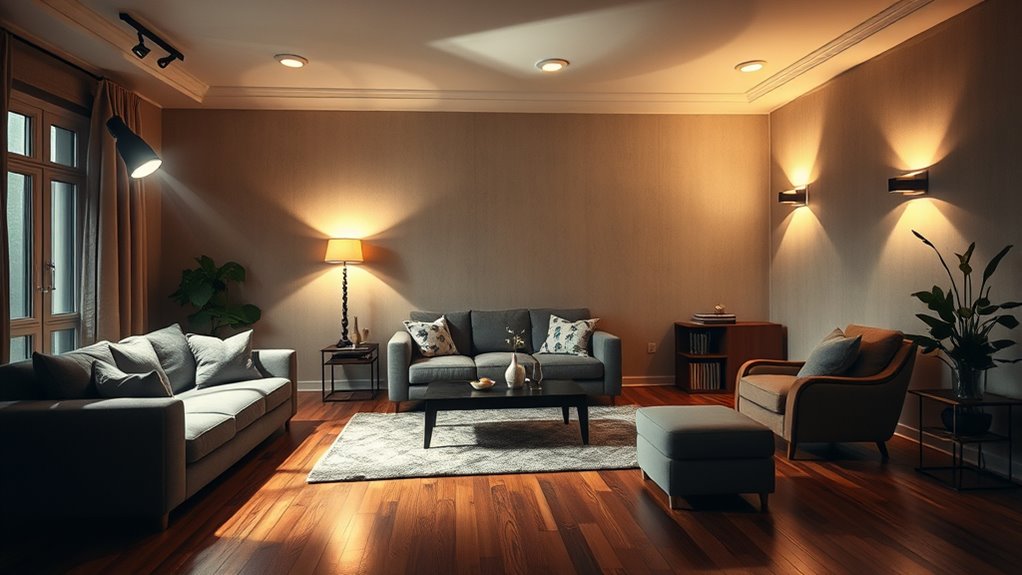
If you use the same lighting style and color temperature throughout your home, it can make each space feel uniform and lacking in personality. To create a warm, inviting atmosphere, you need to adjust your lighting for different rooms. Consider these tips:
- Use softer, warmer lighting in living and bedrooms to enhance coziness.
- Incorporate layered lighting—combine ambient, task, and accent lights—to add depth.
- Brighten kitchens and workspaces with cooler, brighter lighting for functionality.
- Avoid uniform lighting styles; instead, choose fixtures that suit each room’s purpose and mood.
Not Considering the Color Temperature for Ambiance
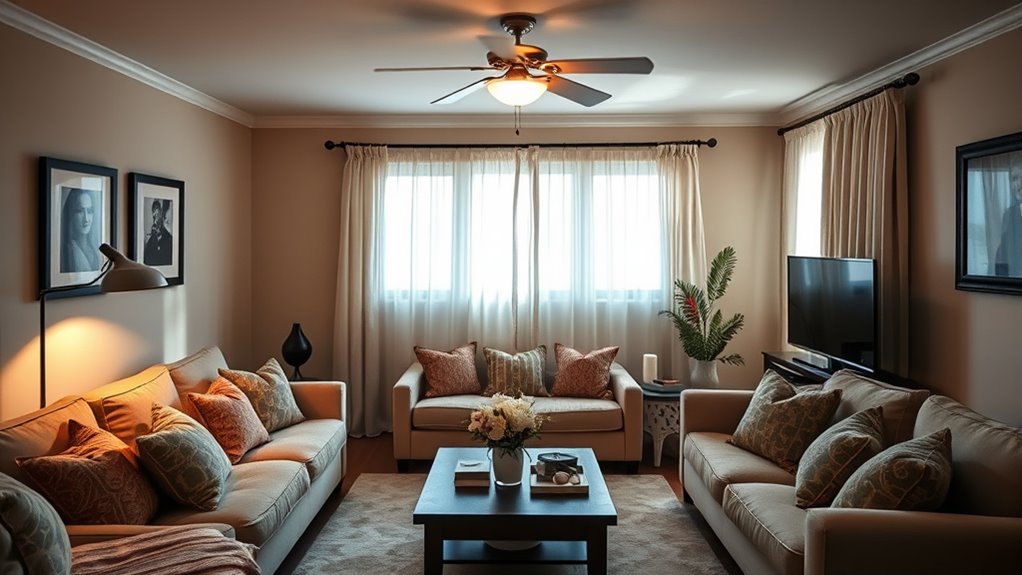
The color temperature of your lighting plays a crucial role in setting the right mood and ambiance in each room. If you choose bulbs with a high Kelvin rating (above 4,000K), your home can feel cold and sterile, which clashes with warm paint colors and makes spaces less inviting. For relaxing areas like bedrooms and living rooms, warm white bulbs (around 2,400K to 3,000K) create a cozy, luxurious atmosphere. In home offices, cooler temperatures might seem practical, but too much cool white lighting can feel harsh and unwelcoming. Switching to warmer lighting instantly elevates your space’s style and comfort. By matching your color temperature to the room’s purpose, you enhance your home’s ambiance and prevent it from feeling cheap or uninviting.
Frequently Asked Questions
What Makes a Home Look Cheap?
You might think your home looks cheap if it’s cluttered or filled with mismatched, outdated fixtures. Overly trendy decor or busy patterns can also cheapen the vibe. When hardware, furniture, and colors don’t match or feel inconsistent, it creates a disjointed look. Avoiding these pitfalls and choosing cohesive, high-quality fixtures and a streamlined design will help your home appear more upscale and inviting.
How to Make a Home Look Expensive on a Budget?
Imagine your home as a canvas—lighting is the brushstroke that transforms it. To make it look expensive on a budget, incorporate layered lighting with affordable fixtures like table lamps and sconces. Place lights at different heights for visual interest, and choose warm bulbs to instantly add richness. Swap out outdated fixtures for sleek, modern options, and combine ambient, task, and accent lighting to create a luxurious, welcoming atmosphere without breaking the bank.
Conclusion
Avoid that one lighting mistake, and your home will glow with warmth and charm. Imagine soft, layered lights casting gentle pools of glow, highlighting your favorite corners and creating cozy ambiences. When you choose the right fixtures and adjust your lighting, your space transforms from dull to inviting, like a well-lit haven. Don’t let harsh, cold bulbs keep your home feeling cheap—embrace layered, warm lighting, and watch it come alive with character.
